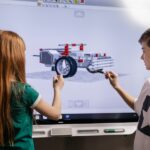Rise of Microlearning, In today’s fast-paced world, traditional learning methods are evolving to keep up with the demands of learners. Microlearning, a concept gaining significant attention, offers an effective solution by delivering bite-sized lessons for maximum retention. This article explores the rise of microlearning, its characteristics, benefits, and implementation in various contexts.
Microlearning has experienced a remarkable surge in popularity in recent years. Learners are increasingly seeking concise and focused learning experiences that can be easily consumed in short periods. This rise can be attributed to several factors, including the need for just-in-time learning, the proliferation of mobile devices, and the recognition of cognitive benefits associated with shorter learning sessions.
Read More: The Future of Education: Virtual and Augmented Reality in the Classroom
Explore the Contents
Characteristics of Microlearning
Rise of Microlearning, At its core, microlearning focuses on delivering learning content in bite-sized modules. These modules are designed to be concise, engaging, and highly targeted. Microlearning leverages various formats such as videos, infographics, quizzes, and interactive assessments to enhance learner engagement. Additionally, it ensures accessibility across multiple devices, allowing learners to access content whenever and wherever they want.

Enhancing Retention through Microlearning
Rise of Microlearning, Microlearning leverages the principles of cognitive science to enhance retention. Short, frequent learning sessions enable learners to absorb information more effectively and maintain focus. Furthermore, techniques like spaced repetition and reinforcement are often incorporated into microlearning experiences, ensuring that learners revisit and reinforce important concepts at optimal intervals. Gamification elements, such as points, badges, and leaderboards, further motivate learners and drive engagement.
Microlearning in the Workplace
Rise of Microlearning, The application of microlearning in the workplace has proven to be highly beneficial. It offers opportunities for upskilling and professional development, enabling employees to acquire new knowledge and skills in a time-efficient manner. Microlearning also caters to just-in-time learning needs, where employees can access relevant information immediately before applying it in their tasks. For organizations, microlearning offers cost-effectiveness and flexibility, reducing the time and financial investments required for extensive training programs.
Designing Effective Microlearning Experiences
Rise of Microlearning, To create effective microlearning experiences, it is crucial to identify clear learning objectives and understand the target audience. Complex topics should be broken down into manageable modules, each focusing on a specific concept or skill. Interactive elements, such as quizzes, simulations, and gamified challenges, can be incorporated to enhance learner engagement and reinforce learning outcomes. Regular assessments help track learner progress and identify areas for improvement.
Implementing Microlearning in Education
Rise of Microlearning, Microlearning complements traditional classroom instruction in educational settings. It provides an opportunity to reinforce learning outside the classroom, catering to diverse learning styles and individual needs. Microlearning platforms and tools offer educators the means to deliver personalized learning experiences, allowing students to progress at their own pace and revisit content as needed. Additionally, microlearning facilitates the integration of multimedia elements, making learning more engaging and interactive.
Overcoming Challenges in Microlearning
Rise of Microlearning, While microlearning offers numerous benefits, there are challenges that need to be addressed for optimal results. One challenge is striking the right balance between brevity and depth of content. It is important to ensure that the content remains meaningful and informative without sacrificing its essence. Content relevance and accuracy are also crucial factors, as outdated or irrelevant information can hinder the learning process. Tracking learner progress and assessing the effectiveness of microlearning experiences are additional challenges that require robust evaluation methods and data analysis.

Future Trends in Microlearning
Rise of Microlearning, The future of microlearning is promising, with emerging trends that will further enhance its effectiveness. Adaptive microlearning, driven by learner performance and preferences, will allow for personalized learning experiences tailored to individual needs. Integration of Artificial Intelligence (AI) and machine learning algorithms will enable intelligent content recommendations and adaptive assessments. Moreover, virtual and augmented reality technologies will bring immersive and interactive microlearning experiences, making education and training more engaging and impactful.
Rise of Microlearning, Conclusion
Rise of Microlearning, Microlearning has emerged as a powerful learning approach, revolutionizing the way we acquire knowledge and skills. Its bite-sized lessons, focused content, and accessibility have made it an attractive choice for learners across various domains. By embracing microlearning, organizations and educators can unlock the full potential of learners, enabling them to achieve maximum retention and apply their knowledge effectively.
Read More: 7 Important Roles of Big Data in Improving Education Outcomes

FAQs
FAQ 1: How long should a microlearning lesson be?
Microlearning lessons typically range from a few minutes to around 15 minutes. The goal is to deliver concise and focused content that can be easily consumed in a short period, maximizing learner engagement and retention.
FAQ 2: Can microlearning be used for technical subjects?
Absolutely! Microlearning is a versatile approach that can be applied to various subjects, including technical topics. By breaking down complex subjects into smaller modules, learners can grasp technical concepts more effectively and reinforce their understanding over time.
FAQ 3: Are there any disadvantages of microlearning?
While microlearning offers many advantages, it is not suitable for every learning scenario. It may not be ideal for in-depth and comprehensive learning or when a subject requires a deeper understanding. Additionally, designing high-quality microlearning experiences requires careful planning and instructional design expertise.
FAQ 4: How can microlearning benefit remote learners?
Microlearning is particularly beneficial for remote learners who may face distractions and time constraints. The short and focused nature of microlearning allows learners to fit learning into their schedules, access content from anywhere, and stay engaged even in remote or virtual environments.
FAQ 5: Can microlearning replace traditional learning methods?
Microlearning is not meant to replace traditional learning methods entirely. Instead, it complements them by providing flexible and supplementary learning opportunities. While traditional methods offer in-depth knowledge, microlearning offers quick refreshers, reinforcement, and just-in-time information, ensuring a well-rounded and effective learning experience.



